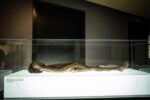Eduard Habicher – Uni-Verso
.jpg)
Installazione esterna curata da Gabriele Salvaterra. L’iniziativa rientra tra i Main Projects di Art City Bologna 2019 in occasione di Arte Fiera.
Comunicato stampa
Eduard Habicher. Entrare a riveder le stelle
Tra David Smith e Marc Di Suvero, passando da Anthony Caro e senza dimenticare nomi di illustri precursori in grado di aprire nuove vie come quello di Julio González, si è sviluppato nel corso del Novecento un percorso per la scultura contemporanea che, partendo dall’oggetto-trovato – spesso di provenienza industriale – saldato e assemblato, riesce ad avventurarsi nei territori dell’espressione e della poesia, sovvertendo i presupposti freddi e refrattari dei materiali di partenza. Non è un caso che l’espressionismo astratto in scultura si sostanzi proprio in queste procedure di composizione di unità distinte, dove l’aspetto oggettuale delle parti riesce a connettersi paradossalmente al vissuto dell’autore e al suo inconscio, “scaldandosi” al fuoco del suo essere.
Eduard Habicher si posiziona in questo flusso ancora vivo della scultura contemporanea con il suo inimitabile apporto, quello che riserva alla piegatura e alla curvatura di un materiale costruttivo funzionale e assolutamente impenetrabile, un senso di delicatezza, di disegno spontaneo che si muove a costellare lo spazio attraverso i suoi vuoti. Volutamente malsicuro e tremolante in alcuni passaggi, accelerato e deciso in altri, non si può fare a meno di seguire con lo sguardo le rosse matasse ingarbugliate dell’autore come le sue rette chiaramente impostate, per poi lasciare al proprio corpo il compito della verifica e dell’esperienza diretta di percorsi poco prima seguiti con gli occhi.
Nel cortile di Palazzo d’Accursio, Habicher sviluppa un fluire nello spazio, un disegnare in esso e con esso (ricordando la felice espressione di González, approfondita da Rosalind Krauss), che riesce a essere tenue senza rinunciare alla monumentalità. Si tratta di una struttura che porta l’imponenza alla dimensione umana, lasciandosi percorrere e attraversare, evitando di nascondere ciò che sta dietro, preferendo sedersi, se così si può dire, accanto alle altre cose. Quella di Habicher è una pratica di delimitazione e commento spaziale che ha la stessa efficacia costruttiva e semplicità della tensione di una corda in un ambiente o del tracciato di un solco in un campo: senza snaturare, segna. Il materiale, banali putrelle da costruzione, si tradisce e verifica continuamente, smaterializzandosi nel puro disegno mentale e confermandosi in proprietà di tenuta ed elasticità attentamente verificate.
In questa struttura-caverna dal sapore arcaico che mira alla totalità del cosmo si può cercare rifugio per l’animo, ma ciò che si trova non è necessariamente l’esclusione di tutto quanto sta fuori, quanto un entrare in cui è comunque possibile osservare le stelle.
________________________________________________________________
Outdoor installation curated by Gabriele Salvaterra. The installation belongs to the Main Projects by Art City Bologna 2019 during Arte Fiera
Eduard Habicher. Entrare a riveder le stelle
In-between David Smith and Marc Di Suvero, through Anthony Caro – whilst not forgetting other eminent forerunners able to pave new ways like Julio González – a path for contemporary sculpture developed during the 20th century. Starting from the found-object – often welded and assembled and of industrial origin – the sculpture manages to venture into the territories of expression and poetry, subverting the cold and refractory assumptions of the raw materials. It is no coincidence that the abstract expressionism in sculpture takes its shape exactly within these composition processes between distinct units, where the objectified aspect of the parts manage to connect paradoxically with the experience lived by the artist and his subconscious, “ignited” by the fire of his being.
Eduard Habicher can be placed in this still existing stream of contemporary sculpture with his inimitable contribution, giving to the bending and the curvature of a functional – and absolutely impenetrable – construction material a sense of delicacy and of instinctive drawing which scatters in the space through its empty spaces. Purposely unsteady and flickering at times, accelerated and sharp on other occasions, the viewer cannot help but follow the author’s red tangled skeins as well as his markedly structured straight lines, and then leave it to ourselves to verify and live first- hand those paths which shortly before were followed by our eyes.
In the atrium of Palazzo d'Accursio, Habicher develops a flow in space, a drawing with and within it (remembering the happy expression of González, deepened by Rosalind Krauss), which manages to be tenuous without sacrificing monumentality. It is a structure that brings grandeur to the human dimension, letting itself be traversed and crossed, avoiding hiding what is behind it, preferring to sit back, if one might say, alongside other things. Habicher makes a spatial delimitation and commentary activity which has the same constructive effectiveness and simplicity of stretching a string in an environment or a furrow being traced in a field: without distorting it, it leaves a mark. The material – ordinary construction beams – betrays itself and continually checks, dematerializing itself in pure mental drawing and confirming itself in a carefully tested tightness and flexibility.
In this archaic cave-like structure – which aims at the totality of the cosmos – the viewer can seek refuge for the soul, but what is found is not necessarily the exclusion of all that is outside, rather a gateway to stargazing.



